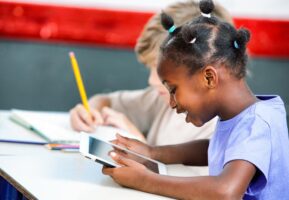
Many in the education community celebrate the potential of technology to help prepare students for the future. But realizing that potential depends on how educational technology tools are used, an area in which gaps persist on average between high-poverty schools and their better-resourced peers. An important goal is to introduce new technologies in ways that reduce rather than exacerbating existing inequalities, especially in low-income schools.
The Apple and ConnectED initiative seeks to address those inequalities by improving learning opportunities for students in America’s most underserved communities.
The initiative provides iPads and other technology, along with professional learning, process management, and technology support services, to 114 schools across the U.S. where a minimum of 96 percent of students receive free and reduced-price lunch based on their families’ household income. The initiative’s comprehensive approach, offering teachers and students not only new tools but also the support necessary to take full advantage of those tools, makes it an important testbed for research on how to meaningfully improve technology-enabled teaching and learning in diverse high-poverty settings.
Researchers at SRI International, in collaboration with Digital Promise, are conducting a rigorous, six-year, mixed-methods study of the Apple and ConnectED initiative’s implementation and outcomes. The research includes surveys of teachers, principals, and students; school case studies; collections of sample lessons and student work; and a study of achievement outcomes.
While education technology research often focuses only on the initial adoption phase, this study’s extended data collection period will also provide insights into how the program matures and gauge its sustainability. How technology-enabled learning programs fare over time is critical to study in high-poverty contexts, where turnover among teachers and school leadership as well as external barriers tend to be more prevalent and can make it harder for positive changes to take root.
SRI recently released the first in a series of reports on evaluation results from the research. The report focuses on early experiences in participating schools—after approximately a year of implementation—based on surveys of teachers, principals, and students. See highlights from initial findings below and read more here:
After about a year, teachers report extensive use of the iPads in their classrooms on average, and overall ratings from teachers and students are positive. Nearly all teachers agree (98%) that the initiative has been positive for their school, particularly in supporting student engagement, learning, and preparation for future success. Three-fourths of surveyed teachers (75%) reported using the new tools in their classrooms daily, suggesting that uptake has been rapid on average in many participating schools.
Hands-on, sustained support for professional learning makes a difference. While teacher reports vary, most teachers consider the professional learning support they received from Apple to be more sustained, hands-on, and focused on their needs than the typical professional development they’ve experienced. These characteristics are commonly shown to be important components of quality. Teacher reports further suggested stronger outcomes in uses of new lessons, teachers’ confidence in using technology for teaching and learning, and comfort in allowing students to take initiative.
Deeper learning is progressing on a longer path. The research defines “deeper learning” along several dimensions: teamwork, communication, personalization, critical thinking, and real-world engagement. Overall, teacher reports indicate that opportunities for deeper learning increased in participating classrooms in the initiative’s first year. Many of the increases that are visible so far seem to be directly enabled by the affordances of the iPads: for example, in participating schools access to learning games at elementary grades often promote personalized subject matter learning for students, and resources such as Keynote and iMovie are used extensively for creative expression of what students have learned. Lesson redesign to promote critical thinking and other deeper changes to learning opportunities are beginning to emerge but are not yet widespread.
Many students report that teachers know them better. An important aspect of a positive learning environment is the degree to which students feel personally known to their teachers. About two-thirds of elementary students and one-third of high-school students indicated that the iPads helped in this regard. Students reported the iPads gave them more opportunities to express themselves and their personal interests, and also allowed their teachers to better understand their academic progress.
SRI’s research continues to follow the program’s implementation to generate rich stories about technology-enabled teaching and learning environments across diverse high-poverty contexts. Future reports will describe the student learning outcomes that may result from program-related changes to learning environments, and consider issues of sustainability beyond the initial excitement of iPads in the classroom.


